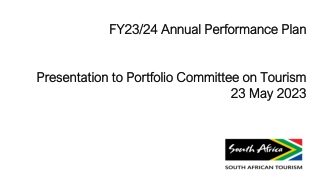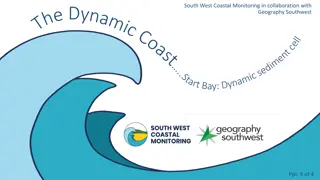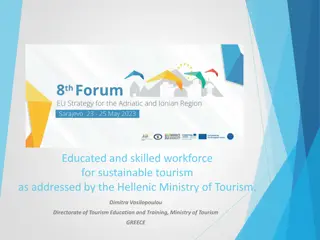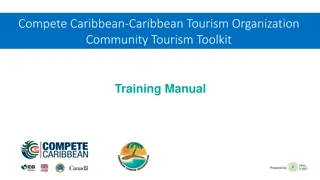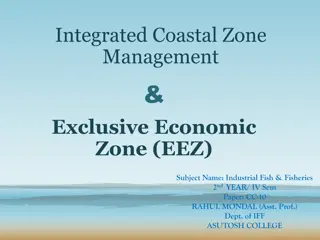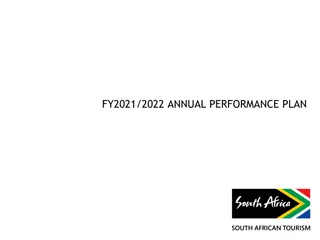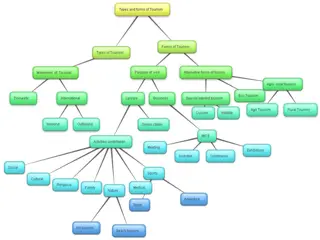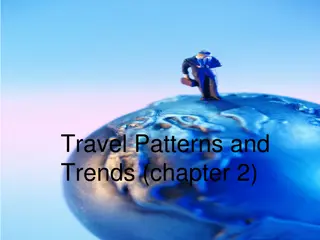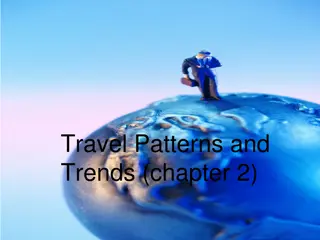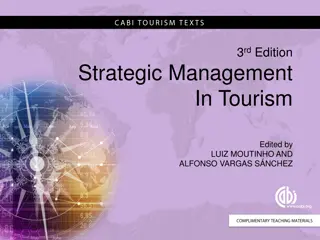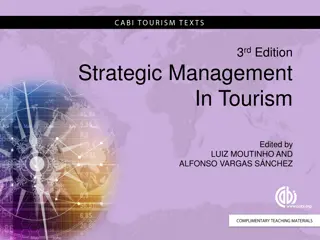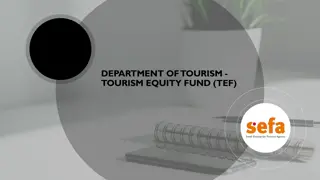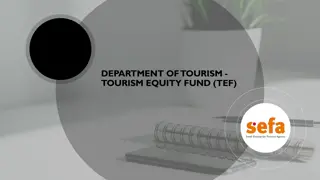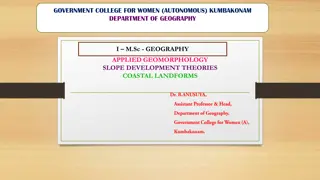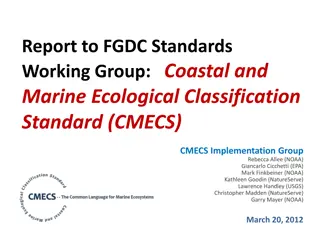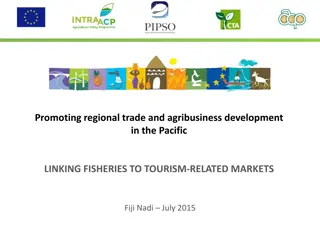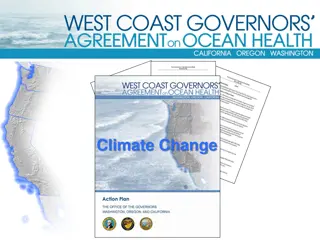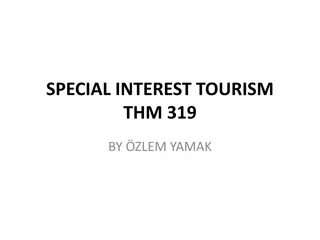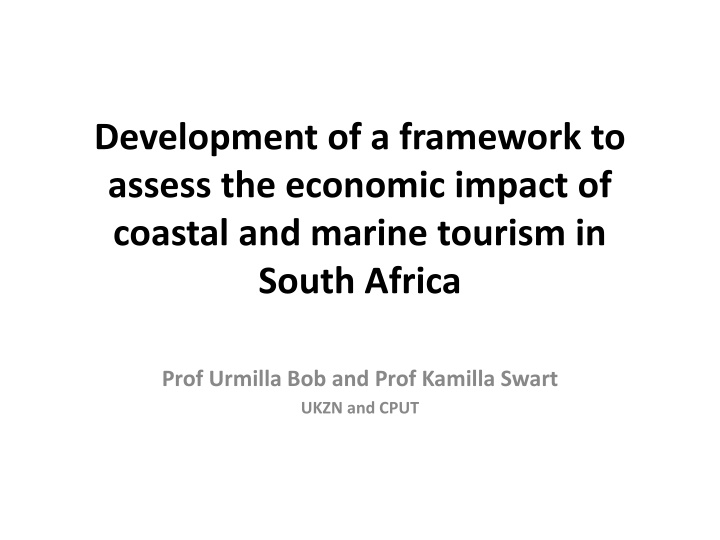
Framework for Assessing Economic Impact of Coastal and Marine Tourism in South Africa
Developing a framework to assess the economic impact of coastal and marine tourism in South Africa is crucial for unlocking the country's ocean economy potential. Operation Phakisa highlights the significant contribution the oceans can make to the GDP by 2033. Challenges such as underutilization of coastal assets, high unemployment rates, and limited private sector engagement need to be addressed. CTM and leisure activities, including marine and coastal tourism, offer various opportunities for economic growth and development in South Africa.
Uploaded on | 4 Views
Download Presentation

Please find below an Image/Link to download the presentation.
The content on the website is provided AS IS for your information and personal use only. It may not be sold, licensed, or shared on other websites without obtaining consent from the author. If you encounter any issues during the download, it is possible that the publisher has removed the file from their server.
You are allowed to download the files provided on this website for personal or commercial use, subject to the condition that they are used lawfully. All files are the property of their respective owners.
The content on the website is provided AS IS for your information and personal use only. It may not be sold, licensed, or shared on other websites without obtaining consent from the author.
E N D
Presentation Transcript
Development of a framework to assess the economic impact of coastal and marine tourism in South Africa Prof Urmilla Bob and Prof Kamilla Swart UKZN and CPUT
Operation Phakisa context and framework Aimed at unlocking the economic potential of the country s oceans as part of unlocking the ocean s economy Highlights that South Africa s oceans are capable of generating an estimated R129 177 billion contribution to the Gross Domestic Product (GDP) by the year 2033 Key challenges identified which include lack of uptake of coastal and marine assets/ resources for tourism purposes, CMT product portfolio, high levels of unemployment and unskilled resources (especially in rural areas and around marine assets), limited participation of the private sector, insufficient infrastructure and underdeveloped and uncoordinated marine related events and recreation Stresses the importance of skills and capacity building as well as research, technology and innovation as enablers Integrated ocean governance and protection CTM Lab
CTM and leisure activities CMT and Leisure Water-based for example, marine coastal zones, seas, oceans and ice-associated areas Coast/ beach development accommodation, restaurants, food industry, and second homes, and the infrastructure supporting coastal development Tourism any activity undertaken when a person is outside his or her usual environment for a specified period of time" Leisure/ recreation a wide variety of activities which are undertaken out of choice during leisure or play
Marine tourism and coastal tourism identified by the CMT Lab (NDT, 2016) Marine Tourism Coastal tourism - Marine wildlife tourism (e.g. seals, dolphins, turtles etc.) Recreational fishing (e.g. boat-based fishing, spear fishing, fishing competitions etc.) Scuba diving/ snorkelling (e.g. shark cage diving) Water sports (e.g. big wave surfing, yachting, water skiing, water surfing etc.) Ocean experience (e.g. cruise tourism, marinas, island tourism, under water archaeology etc.) Events (e.g. marine competitions) - Coastal wildlife tourism (e.g. land- based whale watching, marine turtle tours etc.) Sand/ beach sport (e.g. kite-flying, beach combing, sand dune surfing etc.) Coastal heritage and events (e.g. local seafood and cultural tourism, cultural history etc.) Sightseeing (e.g. light house tourism, cycling, marathons etc.) Educational and scientific excursions (e.g. aquariums etc.) Spiritual experiences Pure recreational (e,g, dining out, shopping) - - - - - - - - - - -
Key thematic issues emerging from literature review Growing importance of CMT globally and nationally Growing prominence of water-dependent recreational activities CMT is amongst the largest and oldest sectors of the tourism industry Range of different types of coastal and marine tourism and recreational activities CMT is diverse and covers a range of coastal and marine assets (beyond cruise and beach tourism) Socio-economic and environmental/ conservation roles of CTM emphasised Importance of Marine Protected Areas (MPAs) foregrounded Increasing threats that impact on CTM which includes climate change, economic shifts, security concerns and developmental demands
Economic contributions of CMT case studies Numerous studies focusing on the economic impacts of tourism (many events tourism) but fragmented and limited research on CTM Focus on national and global or product specific contributions (such as whale watching) contributions based primarily on tourism figures Main methodological approaches Survey based (tourists/ visitors and tourism enterprises) Macro-economic analysis drawing on national economic data International datasets (eg. UNTWO)
Main approaches to measure the economic impacts of CMT Cost Benefit Analysis (CBA) Input-Output (I-O) models General equilibrium models Tourism Satellite Account (TSA) Time-series forecasting methods
Issues for consideration Addressing secondary benefits and multiplier effects Types, scope and quality of data/ information required Sample sizes How to ensure reliability and validity?
Guidelines for the economic impact assessment of CMT Simplify the system and approach Develop tools and data collection guidelines to improve data consistency and quality Adopt a consultative and collaborative process Permit comparative and trend analyses over time Research as well as monitoring and evaluation efforts on CTM need to be aligned and consolidated
Key economic indicators Number of CTM visitors Average and overall expenditure patterns of visitors in specific categories Number and quality of jobs in each category (for example, permanent, seasonal and contract as well as disaggregated by gender, race, etc.) Impact on local business (both in terms of direct and indirect/ multiplier effects) Use of local services Impact on regional and national GDP Consideration of economic leakages
Way forward Phase 2 Workshop with key economists and researchers to identify data requirements in relation to methodological approaches to assess the economic impacts of CMT Consultation with Provinces and other key stakeholders in relation to desktop study and draft framework Data audit in relation to macro and micro-economic modelling required Develop methodology (including the drafting of data collection instruments) Piloting methodology Refinement and finalisation of framework for implementation Phase 3 Implementation and refinement of framework

